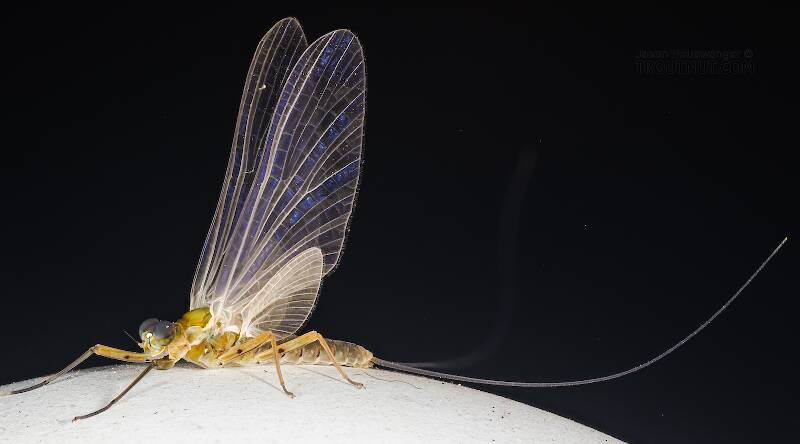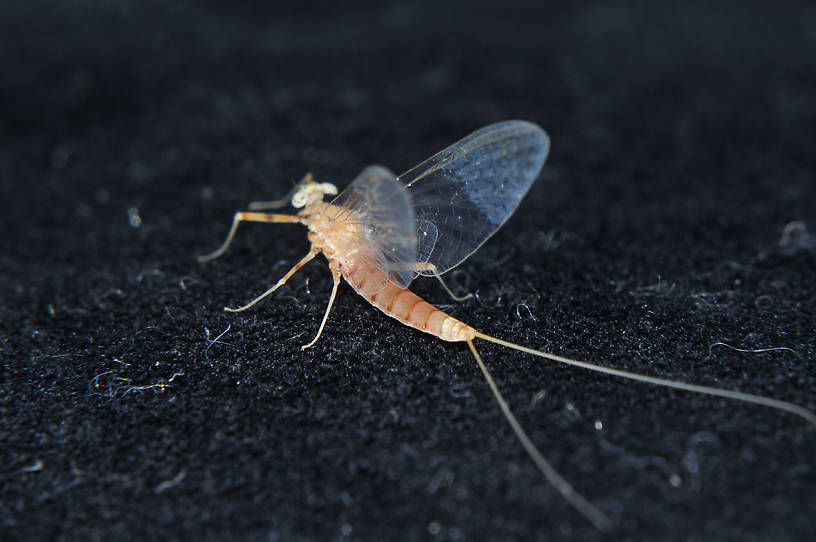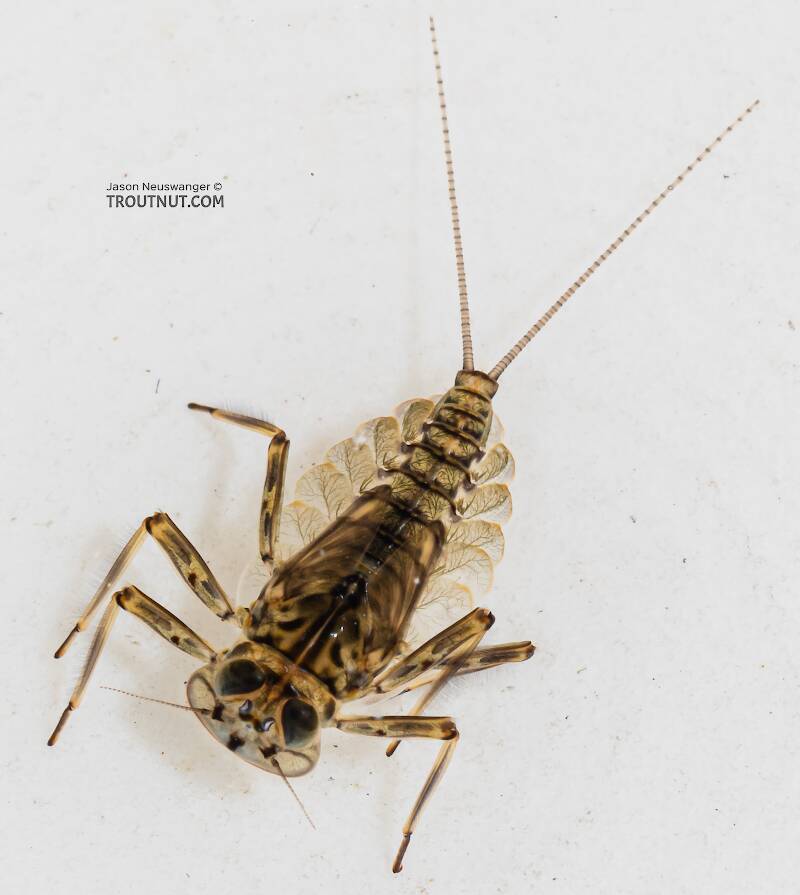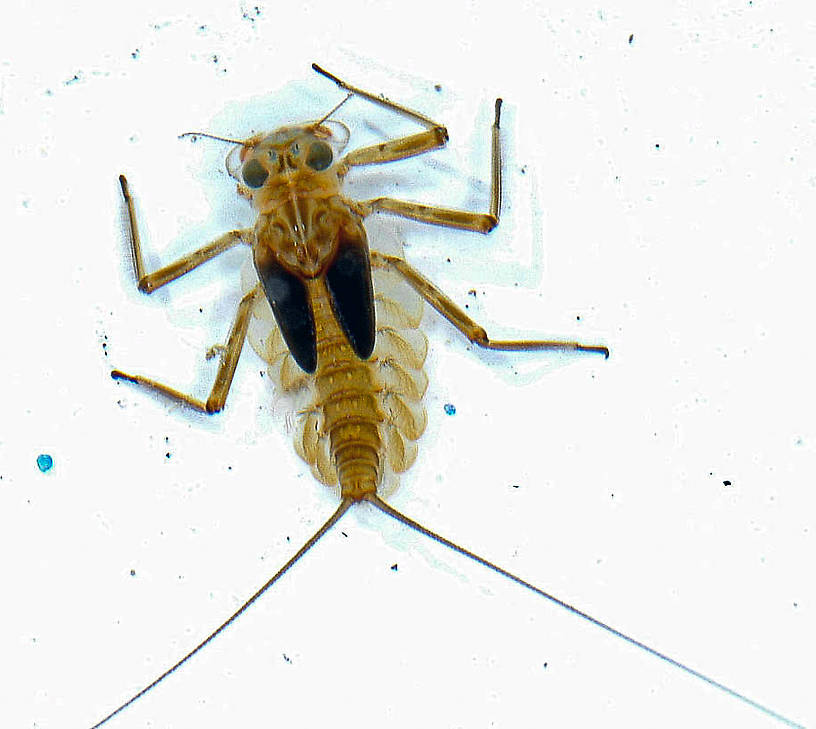
Blue-winged Olives
Baetis
Tiny Baetis mayflies are perhaps the most commonly encountered and imitated by anglers on all American trout streams due to their great abundance, widespread distribution, and trout-friendly emergence habits.

Mayfly Species Epeorus longimanus (Slate Brown Duns)
Where & when
In 25 records from GBIF, adults of this species have been collected during July (32%), August (32%), June (20%), and September (16%).
In 42 records from GBIF, this species has been collected at elevations ranging from 259 to 10840 ft, with an average (median) of 6713 ft.
Species Range
Spinner behavior
Time of day: Midday
Habitat: Fast water
Nymph biology
Current speed: Fast
Physical description
Most physical descriptions on Troutnut are direct or slightly edited quotes from the original scientific sources describing or updating the species, although there may be errors in copying them to this website. Such descriptions aren't always definitive, because species often turn out to be more variable than the original describers observed. In some cases, only a single specimen was described! However, they are useful starting points.
Male Spinner
Wing length: 10-11 mm
A rather pale brownish species; genitalia of the longimanus type (now a synonym of Epeorus longimanus). (see fig. 105).
Head light reddish brown. Thoracic notum light yellowish to reddish brown ochre, pleura and sternum very similar in color. Fore femur and tibia “translucent raw umber” (Eaton); other femora similar, tibiae yellowish brown. All femora with a round black spot near the middle; fore tibia blackish at apex. Fore tarsus dull yellowish brown, middle and hind tarsi slightly paler in color; tarsal joinings may appear somewhat darker. Wings hyaline; venation light brownish amber, the humeral cross vein, base of subcosta and other longitudinal veins behind it, paler; veins in hind wing rather pale.
Abdominal tergites 2-9 “tinged extensively with light brownish” (Eaton); 9 and 10 often light brown-ochre. Tergites 2-7 semi-hyaline; posterior margins deep purplish brown, this band not extending around the postero-lateral angle, but a short dark oblique streak arising from this dark band runs to the spiracular area. Purplish brown shading along mid-dorsal line; median line narrowly pale, with darker streak on each side. Pale lunate submedian marks on each side lie within the shaded area. Segments 8-10 opaque. Sternites pale yellowish; nerve cord and ganglia whitish, opaque; sometimes traces of pale submedian oblique streaks on basal and middle segments. Tails “light warm sepia brown” (Eaton). Apical margin of forceps base projects backward as a dome-shaped structure, concealing the bases of the penes. Each division of the penes has an erect apical lobe and a larger laterally-directed one, bearing a sharp lateral spine. A median pair of strong spines is present, their tips divergent.
In type of genitalia this western species is allied to the eastern I. fraudator (now a synonym of Epeorus pleuralis), I. fragilis (now a synonym of Epeorus fragilis) and I. tenuis (now a synonym of Epeorus fragilis). It is larger and somewhat darker in color than either of the two latter species. The lobes of the penes are likewise much less deeply cut than in any of the three. The darkest specimens we have seen are slightly paler than typical fraudator, which is likewise a little larger than I. longimanus.
Described as I. proprius
Body length 9-10 mm, wing length 10 mm
Similar in general appearance to I. longimanus (now a synonym of Epeorus longimanus), but with genitalia of the pleuralis (now a synonym of Epeorus pleuralis) type.
The only specimens available are so faded from long immersion in alcohol that it is impossible to be certain of the original color. However, they seem to have been very similar to I. longimanus, from which species they are distinguishable mainly by the very different type of genitalia. A comparison of these with specimens of longimanus which likewise have been in alcohol for several years, shows that the dark spot on each femur is smaller and less distinct than in the latter species. The oblique black streak present on the postero-lateral angles of the tergites in I. longimanus, is apparently lacking in I. proprius (now a synonym of Epeorus longimanus). Genitalia very similar to I. pleuralis, but smaller; chitinized appendage attached to dorsal lobe of penes is narrower and more distinctly sickle-shaped than in that species. (See fig. 106).
Specimens of the Mayfly Species Epeorus longimanus
1 Male Dun

Both Epeorus albertae and Epeorus dulciana should have a conspicuously darkened humeral crossvein in the forewing. This one doesn't.
The foretarsal claws are dissimilar (one sharp, one blunt), which also rules out the Epeorus albertae group.
The dark macula on the forefemora rules out Epeorus deceptivus, which is also supposed to be a little bit smaller.
Both Epeorus grandis and Epeorus permagnus should be much, much larger.
Of the species known to be present in Washington, this leaves only Epeorus longimanus, which is exactly the right size. The key to male spinners in Traver (1935) describes distinctive markings that are visible (although more faintly) in this dun: “Black posterior margins of tergites do not extend laterally to pleural fold, but an oblique black line form this margin cuts across poster-lateral triangle to pleural fold.”
1 Female Spinner
3 Nymphs
Start a Discussion of Epeorus longimanus
References
- Arbona, Fred Jr. 1989. Mayflies, the Angler, and the Trout. Nick Lyons Books.
- Caucci, Al and Nastasi, Bob. 2004. Hatches II. The Lyons Press.
- Knopp, Malcolm and Robert Cormier. 1997. Mayflies: An Angler's Study of Trout Water Ephemeroptera . The Lyons Press.
- Needham, James G., Jay R. Traver, and Yin-Chi Hsu. 1935. The Biology of Mayflies. Comstock Publishing Company, Inc.
- Schwiebert, Ernest G. 1955. Matching the Hatch. MacMillan Publishing Company.
- Swisher, Doug and Carl Richards. 2000. Selective Trout. The Lyons Press.
Mayfly Species Epeorus longimanus (Slate Brown Duns)
Species Range
Common Names
Resources
- NatureServe
- Integrated Taxonomic Information System
- Global Biodiversity Information Facility
- Described by Eaton (1885)






